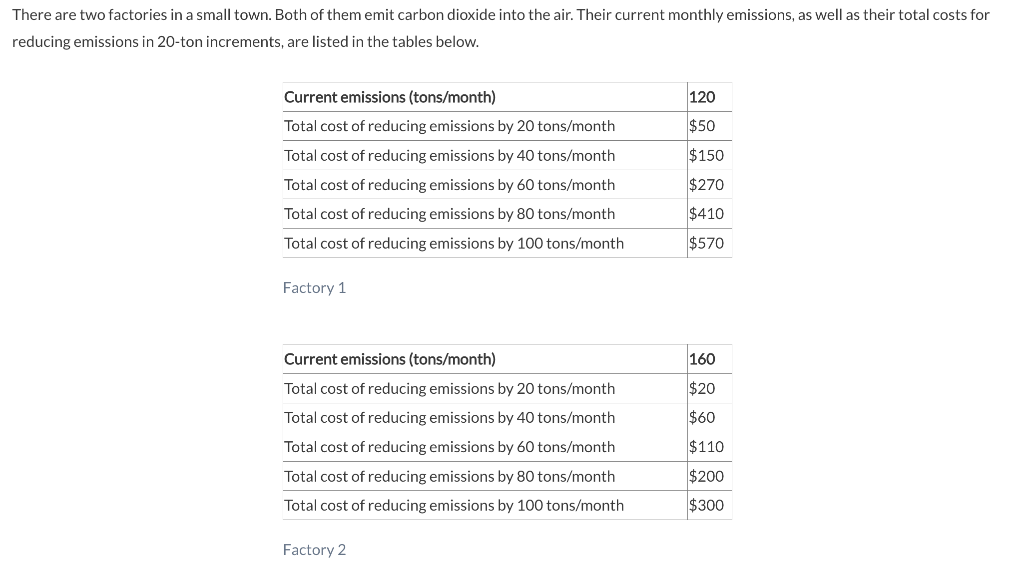Assume that the existing technology does not allow for reductions in emissions beyond 100 tons/month. That is, the most each factory can reduce its emissions is 100 tons/month. Also assume that if a factory owner is indifferent between reducing pollution or paying taxes, the factory owner will choose to reduce pollution. With those assumptions in mind, suppose the government has a goal of reducing total monthly emissions by 160 tons. To achieve this goal, the government has decided to impose a tax on pollution. That is, for every 20-ton emission, a factory will have to pay some amount of money. To achieve (but not exceed) the desired reduction in emissions, the tax will have to be set equal to or above $ per 20 tons/month. but below $
Assume that the existing technology does not allow for reductions in emissions beyond 100 tons/month. That is, the most each factory can reduce its emissions is 100 tons/month. Also assume that if a factory owner is indifferent between reducing pollution or paying taxes, the factory owner will choose to reduce pollution. With those assumptions in mind, suppose the government has a goal of reducing total monthly emissions by 160 tons. To achieve this goal, the government has decided to impose a tax on pollution. That is, for every 20-ton emission, a factory will have to pay some amount of money. To achieve (but not exceed) the desired reduction in emissions, the tax will have to be set equal to or above $ per 20 tons/month. but below $
Managerial Economics: A Problem Solving Approach
5th Edition
ISBN:9781337106665
Author:Luke M. Froeb, Brian T. McCann, Michael R. Ward, Mike Shor
Publisher:Luke M. Froeb, Brian T. McCann, Michael R. Ward, Mike Shor
Chapter16: Bargaining
Section: Chapter Questions
Problem 2MC
Related questions
Question
Please don't provide answer in image format thank you

Transcribed Image Text:There are two factories in a small town. Both of them emit carbon dioxide into the air. Their current monthly emissions, as well as their total costs for
reducing emissions in 20-ton increments, are listed in the tables below.
Current emissions (tons/month)
Total cost of reducing emissions by 20 tons/month
Total cost of reducing emissions by 40 tons/month
Total cost of reducing emissions by 60 tons/month
Total cost of reducing emissions by 80 tons/month
Total cost of reducing emissions by 100 tons/month
Factory 1
Current emissions (tons/month)
Total cost of reducing emissions by 20 tons/month
Total cost of reducing emissions by 40 tons/month
Total cost of reducing emissions by 60 tons/month
Total cost of reducing emissions by 80 tons/month
Total cost of reducing emissions by 100 tons/month
Factory 2
120
$50
$150
$270
$410
$570
160
$20
$60
$110
$200
$300

Transcribed Image Text:Assume that the existing technology does not allow for reductions in emissions beyond 100 tons/month. That is, the most each factory
can reduce its emissions is 100 tons/month. Also assume that if a factory owner is indifferent between reducing pollution or paying
taxes, the factory owner will choose to reduce pollution.
With those assumptions in mind, suppose the government has a goal of reducing total monthly emissions by 160 tons. To achieve this
goal, the government has decided to impose a tax on pollution. That is, for every 20-ton emission, a factory will have to pay some
amount of money. To achieve (but not exceed) the desired reduction in emissions, the tax will have to be set equal to or above $
per 20 tons/month.
but below $
Expert Solution
This question has been solved!
Explore an expertly crafted, step-by-step solution for a thorough understanding of key concepts.
This is a popular solution!
Trending now
This is a popular solution!
Step by step
Solved in 4 steps

Knowledge Booster
Learn more about
Need a deep-dive on the concept behind this application? Look no further. Learn more about this topic, economics and related others by exploring similar questions and additional content below.Recommended textbooks for you

Managerial Economics: A Problem Solving Approach
Economics
ISBN:
9781337106665
Author:
Luke M. Froeb, Brian T. McCann, Michael R. Ward, Mike Shor
Publisher:
Cengage Learning

Managerial Economics: A Problem Solving Approach
Economics
ISBN:
9781337106665
Author:
Luke M. Froeb, Brian T. McCann, Michael R. Ward, Mike Shor
Publisher:
Cengage Learning